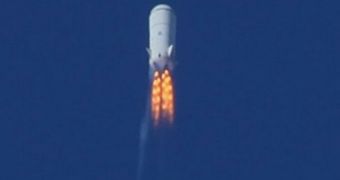According to an update posted on the official Blue Origin website, the company experienced an important setback last week, when the prototype suborbital rocket it is developing for cheaper spaceflights was destroyed high above the ground.
Amazon.com founder and Blue Origin CEO Jeff Bezos said in the update that the private entrepreneurial space group is already at work in replacing the lost vehicle. He added that a technical glitch was the reason for which the spacecraft was destroyed.
The company is usually very secretive about both the reusable suborbital rocket and the New Shepherd crew capsule it is developing for sending astronauts to space. It is working with funds from the American space agency, under the Commercial Crew Development (CCDev) program.
In fact, NASA awarded the firm $22 million this April, for the development of novel technologies related to space exploration. Blue Origin is one of four companies working with the space agency under CCDev, alongside SpaceX, Boeing and Orbital Sciences Corporation.
Despite working diligently, engineers at the company could not prevent the flight instability that doomed the prototype test vehicle. Bezos said that error led to an unusual angle of attack that triggered range control safety mechanisms.
This happened shortly after the spacecraft took off from the Blue Origin spaceport. The installation is located approximately 40 kilometers (25 miles) north of Van Horn, Texas. Once the unusual angle of attack was reached, commands were sent to stop thrust, so as to avoid damage on the ground.
“Three months ago, we successfully flew our second test vehicle in a short hop mission, and then last week we lost the vehicle during a developmental test at Mach 1.2 and an altitude of 45,000 feet,” Bezos explained in the September 2 post.
“Not the outcome any of us wanted, but we're signed up for this to be hard, and the Blue Origin team is doing an outstanding job. We're already working on our next development vehicle,” the official added.
The company is working on developing the New Shepherd space capsule as well. At first, it will launch aboard expendable Atlas 5 delivery systems, but Bezos announced some time ago that the capsule would then be launched by a booster currently being developed by Blue Origin.
As the American space agency retired its space shuttles in July, it's spacecraft such as these ones that will ensure US astronauts reach orbit on American-built machines. However, the switch will take years.
In the mean time, NASA relies on its strategic partnership with the Russian Federation to send astronauts to the International Space Station. The space agency and RosCosmos are bound by their cooperation contract until at least 2015, Space reports.

 14 DAY TRIAL //
14 DAY TRIAL //